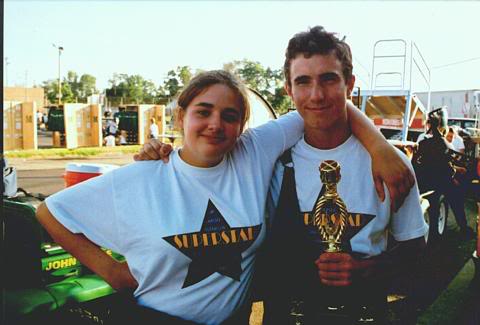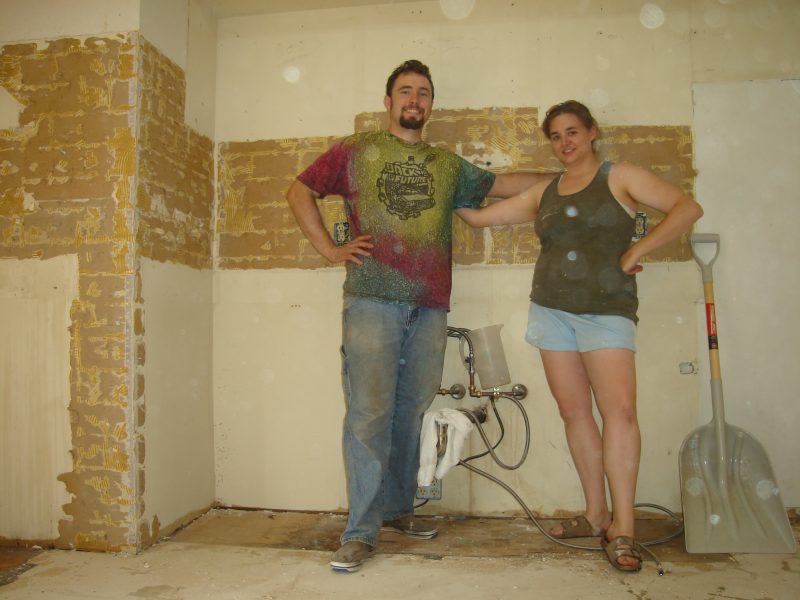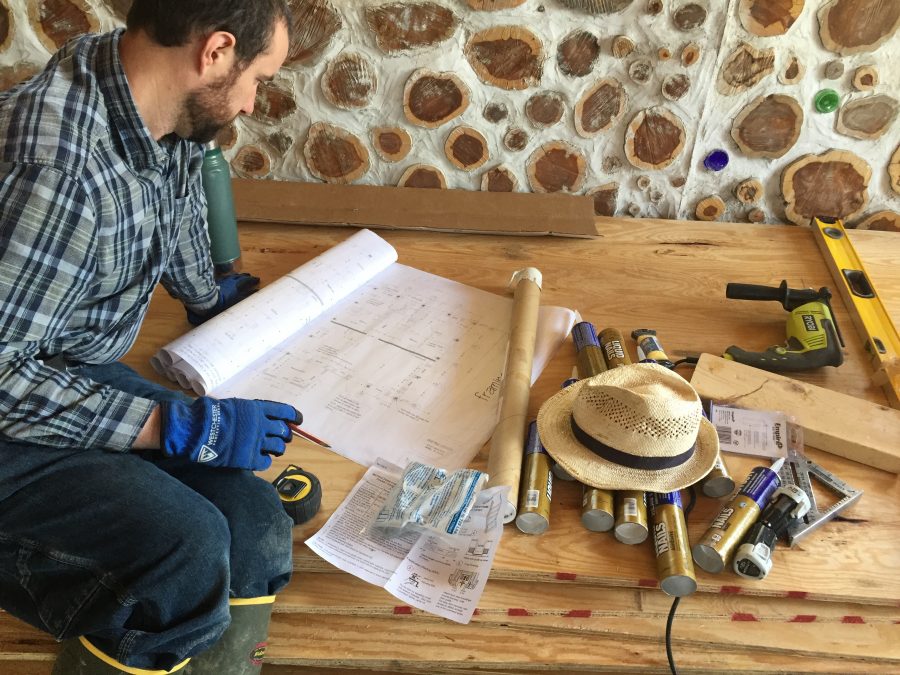Disclosure: I sometimes earn products or commissions from affiliate links or partnerships on my blog. I only recommend products and services I trust to serve you. Learn more.
It’s been just over one year since my husband and I moved into the house that we built by hand. We’ve had many opportunities to reflect since then about our experiences. One of the things we keep coming back to is how lucky we were to have survived the experience. I’m not just talking building safety either (though we do feel lucky to still have all our fingers and eyeballs intact).
You see, the notion of venturing into the woods with your spouse and chopping down trees to build a homestead together is ultra romantic. Lots of people dream of doing it! But if you think for even a moment that your undying love alone will sustain you through the extreme pressures of homebuilding, think again.
If you and your spouse both want to build a home together, there are some critical things you should know before you even look at a home plan book.
First, I want you to know that it was all worth it.
The blood, sweat, and tears that went into every inch of our home were worth it. We had a dream of building an eco-friendly off-grid home and we fought tooth and nail to achieve it. The fact that we get to wake up every day in a home that we designed for ourselves and built on the most beautiful plot of land still gives us immense satisfaction and we thank God for the opportunity.
While I need you to understand that it was 100% worth it, and that it can be for you too, what I’m about to share will give you some hard realities to check. Travel back in time with me…
It’s July 2016. We’d JUST finished putting up the trusses. Not having had an opportunity to sheath them before our crane guy arrived, we had to get up high to put the sheathing on after the fact. No big deal right?
Our trusses are about 15-24 feet above the rocky ground, so we needed some scaffolding to reach up high. It was only two levels high, but to me, it looked like a thousand. I’ve never been the surest on my feet but the job needed to get done even if I wasn’t thrilled about it.
On the other hand, my husband Mark is sure-footed and waaaay braver than I am in most regards. He quickly scaled the scaffolding and hollered down, “You coming up or what? We gotta get this done!”
“Yeah, I’m coming I’m coming. Just give me time.”
The tower swayed and wobbled as I climbed it. Please don’t collapse. Please don’t collapse. It didn’t, and I didn’t fall to the jagged rocks below.
Sheet by sheet, we put the sheathing on.
“Here, Em. Hold this side here while I fasten it.”
“Mark, I can’t reach that. It’s too far away!”
“Well then put one foot on the header and one on the scaffolding. You could reach that!”
I looked down at the 16-foot drop between the scaffold and the roof. He wants me to straddle that?! I took a deep breath and scooted over slowly. I HAD to do this. Please just don’t fall.
I put my foot over the edge and reached out for the header but just couldn’t. It was too far. Too scary.
“Fine. If that’s too much for you just climb down. I’ll figure out how to do it myself.” Mark was clearly exasperated by my apparent unwillingness to risk life and limb for a piece of plywood.
But it wasn’t sheer unwillingness. It was an overwhelming amount of anxiety running through my brain. A highlight reel of every time I’d fallen and everything I’ve ever read about construction site safety data and the number of workers injured from falls every year and the myriad ways I will surely meet my untimely demise and, and and… How can I possibly express all of that in this moment?
So I didn’t, and we spent the rest of the day frustrated and tense. We were both kind of mad at each other for different reasons, but we just kept working and doing our best. Sunset came and we packed it in.
This wasn’t the only tense moment in two years of homebuilding.
Far from it. There is a laundry list of stressful events, like the times:
- We
yelled atworked on the radiant tubing until 3:30 am because we thought the inspector wanted to see it completed at 7:00 am. - We killed Mark’s truck battery using the headlights as work lamps because we just had to get those headers done at 11:00 at night.
- One of our best friends was badly injured helping us with the trusses.
- Code officials required us to do “expensive and frustrating things” just to stay code-compliant.
- We realized we needed to abandon our dreams of doing it 100% debt free if we were ever going to move out of my mom’s house.
And on and on…you get the idea.
This will happen to you too. Are you prepared?
Mark and I are really lucky to have the relationship that we do. We’ve known each other since we were five years old and have been together for the past 19 years of our lives. That’s a long time to learn about each other; our strengths, weaknesses, fears, ambitions, likes, dislikes, and so on. If our relationship wasn’t as strong as it is, we both wager that we might not have made it through 2 years of building stories like the one you just read.
Building a house together brings everything to the forefront. It exposes the best and worst in you. We faced all of it head on together and thankfully we came out on the other side of it still together. But it doesn’t work that well for some people. We’ve learned of many people who set out to build a home together and managed to destroy their relationship in the process.
What’s the difference? We have our suspicions. By no means are we relationship experts, but after 19 years together, 5 years of parenthood, and 2.5 years of homebuilding together, we have some ways for you to assess your relationship and homebuilding readiness before you start.
5 Questions to Ask About Your Relationship BEFORE Building a House
1. How solid is your relationship NOW?
Great relationships are built on a foundation of trust and communication. Those strengths, weaknesses, fears, ambitions, likes, and dislikes I mentioned? You have to know them inside and out, not only about the other person but about YOURSELF as well. Look at the following in YOUR relationship:
- Your level of trust
- Shared respect of one another
- Empathy for each other
- Are you mutual partners or does one tend to dominate the other?
- How much you actually discuss and plan in your daily lives
It isn’t that building a house ruins relationships, it’s that it brings any existing issues to the fore. Before you dive into a huge project like an entire house, evaluate how strong your relationship is. You may entertain the idea of trying smaller projects or volunteering for places like Habitat for Humanity together to see what your working dynamics are like.
Related: Three [money] things you should do as a couple to live that self-sufficient life
2. How will your PERSONALITY TRAITS impact the project?
Before we started, I don’t think I recognized how apprehensive I really was about building a home. I didn’t realize how tall 16 feet really was until I saw it there in front of me and was confronted with working at heights. And with that, I didn’t realize how much more fearless Mark is than I am. Being opposites like this isn’t a bad thing. In fact, it can be quite good!
But if we had been able to process through some of these things before we started, we might have designed a shorter home that BOTH of us would feel safe working on together. We might have also saved a lot of money through better planning, which could have mitigated other arguments later in the project.
More than your ability to use tools or make measurements, your personality traits, and playing to your strengths, will play a huge role in how well your homebuilding journey goes. For example, Mark as the no-nonsense extrovert in our relationship is better suited to calling subcontractors and negotiating prices and deals than I am. I am an introvert to my core and have to rehearse my phone calls before I make them! Knowing this made it a bit easier to divvy up the to-do list, but it didn’t get me completely off the hook. I still had to step out of my comfort zone.
Here are some traits you might consider about each other and how they might influence your project:
- Introversion vs. Extroversion
- Leader vs. Follower
- Risktaker vs. Play it safe
- Willingness vs. Unwillingness to try new things
3. How do you handle CONFLICT?
Homebuilding WILL create conflict within your relationship. You will have to make decisions on everything from the big obvious things like home design to little things like, “should we buy this big value bucket of nails or just the little box today?”. You will have arguments because “You told me to bring in the circular saw and now you’re asking for the hand saw and it’s getting dark we gotta get this done and you’re just IMPOSSIBLE UGH”.
All of these conflicts, big and small, add up.
Think about how you have traditionally handled conflict in your relationship. How do both of you tend to respond, and are you happy with how things usually play out?
If you don’t have a handle on diplomacy and conflict resolution in your relationship, now would be a good time to figure that out.
Related: how busy couples can keep their build (and their sanity) on track
4. What are your actual GOALS?
In almost any endeavor, knowing WHY you really want to do something (and keeping it top of mind) is critical to your success. If you think about it, building a house isn’t really the goal. The goals are what you want that house to do for you.
What do you want your home to really provide for you? Do you want it to turn into a functional homestead? Do you want it to give you the perfect space for a home-based business? Will you want to homeschool in it? Your house is a means to a much larger end.
Taking time during the build to remember WHY you’re creating this home with your own hands and imagining what life could be like living in it will keep you focused and united.
Related: What to consider when planning your homestead layout
Make sure you spend time not only talking about your goals for your home, but writing it down too. Consider what both of you find important in your future space and include those details in your planning. Speaking of…
5. What sort of PLANNING have you done?
It might seem obvious that you need to have blueprints in order to build a house, but the planning process includes so much more than that. You must consider:
- Where you’ll live while you build
- What your monthly budget will look like
- What your building budget will be
- How you’ll pay for your build
- How to get (and maintain) insurance for your build
- The costs of permits and code compliance
and so so so much more.
Consider this: over 20% of marriages fail because of money fights. Your home is likely to be the biggest investment you’ll make together. Now add to that the stresses of building, the conflicts that will definitely arise, and the hard choices you’ll have to make during the build. By not planning for the inner details of your home build, you’re inviting misery and heartache into the mix. Don’t do that! A little bit of care and detail up front will give you so much more joy in your building experience.
It will be so worth it in the end, and your journey as owner-builders will be that much sweeter if you work on building your relationship FIRST.
If you’ve built a house with a spouse or significant other, what advice would YOU offer to others just getting started? Let us know in the comments below!
If you’re ready to seriously consider building a home of your own and you don’t know HOW to start planning for those things, The Owner-Builder Home Planner is a comprehensive resource to guide you through the process. Click here to learn more.
If you’re still just in the dreaming phase, I invite you to get our free Owner-Builder Quick-Start Checklist by subscribing below!
To see how we built our house step-by-step, you can read our homestead progress updates and find out more about our cordwood homestead project here. Be sure to join us on Facebook and Instagram and Pinterest too. Thanks for reading!






